
2012 Shimano XT 1st, 2nd & 3rd Impressions
I went down to Lake Tahoe, California in June for the 2012 Shimano XT launch, and posted a first-look article on the new component group a little while ago. At that time, I had only been on two short rides with the new parts, on trails that were nothing like the goods at home here in BC.
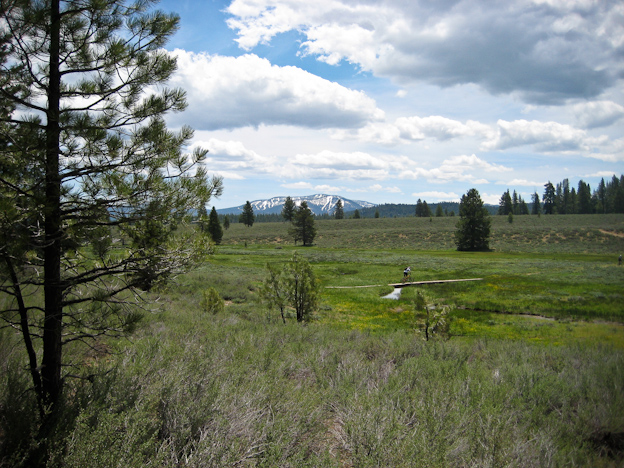
This was the view from the trail on Day 2 in Tahoe. Easy on the eyes, for sure. || Photo: Stuart Kernaghan
I could have posted a first impression article at that time, but I firmly believe that you need to ride New Product X several times on home trails, on your own bike, before you really get an accurate feel for it. So now I’ve had a chance to get in a few rides with the new XT parts here on the Shore and in Squamish, and I can actually say something about the way they work without feeling like I’m talking out of my ass.
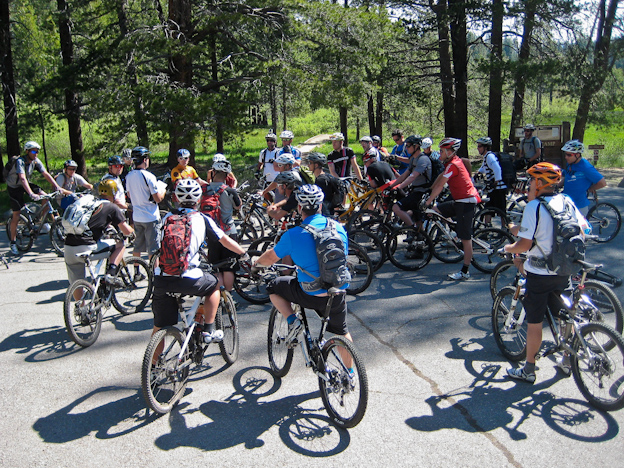
Giving the troops marching orders before we rolled out of the parking lot for ride #2 at the XT launch in NorCal. This had the potential to be a full-on gong show, but it actually worked out just fine. || Photo: Stuart Kernaghan
Shifters
Shimano shifters offer a multitude of bells and whistles for changing gears. You get Instant Release technology for quick shifts, Multi-Release technology so you can upshift two gears with one solid push of the shifter (and three if you’re crafty with the shifting) and 2-Way Release technology, which allows you to push or pull the upshift (small) lever.
In terms of functionality, the XT shifters have worked well from the start. I had to rotate the shifters quite far clockwise on the bar in order to find a comfortable position. The upshift lever is situated close the bar and can almost end up too close to the brake lever if it’s positioned under the bar. Once I found a happy place for the shifters, it’s been all good and shifting has become second nature.
The Vivid Indexing technology is designed to give a very positive feel to shifting when you go from one gear to the next, and does in fact do that. It doesn’t have quite as solid a feeling or sound as the shifting on higher-end SRAM shifters, but it’s very obvious when you’ve shifted from one gear into another. The Instant Release technology did also what it was supposed to and shifts were quick.
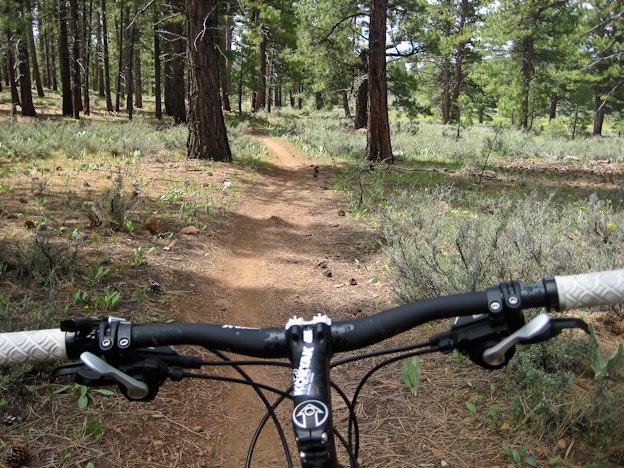
There were long stretches of silky smooth singletrack on Day 2. It was a little unnerving for someone who’s used to wet, slippery roots. The fact that they were still wet and slippery in July is a bit of a sore spot… || Photo: Stuart Kernaghan
One of the really pleasant surprises about the XT drivetrain has been the Multi-Release function. I’m a big fan of it now, and use it all the time. It’s very handy when you’ve crested a hill and are heading down the other side or when you pick up speed on fast singletrack. You can drop half-way down your cassette with two pushes instead of the four that it would take on a SRAM shifter.
Shifting on the XT components has been consistent and has felt very solid, but I have noticed that it’s not quite as buttery as Shimano’s high-end XTR group. I’ve spent most of the past winter riding the new XTR parts and XTR shifting is just that much cleaner and smoother than XT. But that’s what you expect from the top-shelf XTR bits. I doubt most people would notice it if they didn’t ride both back to back, but I’m in the fortunate postion to have done just that. It’s definitely minor, though, and certainly no slight against XT shifting.
Brakes
The brakes were another standout in the new XT group, but they were also a bit of a mixed bag for me. There was a lot of power with the metallic pads and Ice Tech rotors – so much so that I was fine using a 7” / 6” rotor combination instead of my usual 7” / 7” combination. That to me is a definite bonus, especially as a “larger” rider who weighs in at 220 lbs before I’ve geared up.
The tool-free lever reach adjust is very convenient and easy to use, even with gloves on. I’m not a fan of the brake levers themselves, though. They’re too short for my liking, even for one-finger braking and I would prefer something a bit longer. The FreeStroke adjust, which is supposed to change lever feel, doesn’t really seem to do much so I’ve left it alone after some initial tweaking.
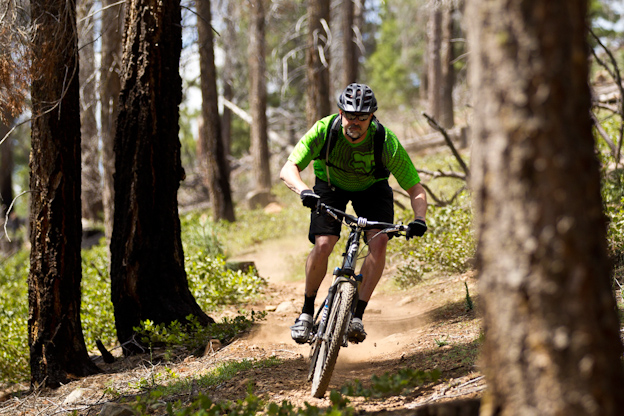
Fast and furious downhills call for serious stopping power. I was expecting that a 7″ / 6″ rotor combo would come up short, but I was pleasantly surprised how well it worked to slow me down. || Photo: Sterling Lorence
The new XT brakes have plenty of modulation and power, thanks to the Servo-Wave levers, but I found that they can have a slightly mushy and indistinct feeling if the reach isn’t dialled out far enough. The tight switchbacks or slow maneuvers that are common on the Shore often required more braking – and more thinking about braking – than I would have preferred until I adjusted the lever reach further out.
Those tendencies wouldn’t have been as much of an issue at speed but when I’m crawling along a trail, I want precise control of the bike. Play with the set-up to dial the braking to your personal preference and trails, and you’ll be happy.
Drivetrain
I’ve been impressed with the XT drivetrain. The XT cranks are standard Shimano fare – the axle is mounted on the driveside crank, held in place with a threaded end cap and two opposing pinch bolts on the non-drive side. Installation is a piece of cake.
I ran the 3 x 10 crankset in California, but switched it to a double and bashguard set-up when I got back to BC. The 42 /32 /24T gearing (now 32 / 24T) mates very well with the 11-36T cassette, and I find that I spend more time in my middle ring than I did in the past with a 9-speed 34T cassette. (The new XT is also available in a 2 x 10 option, if that’s your thing.)
I’m running a medium-cage XT SHADOW rear derailleur, and so far it’s been working well. Shifting has been smooth, there hasn’t been any noticable ghost shifting and chain / derailleur slap has been relatively minimal. The derailleur and chain were definitely able to keep up with fast gear changes with the Multi-Release shifters.
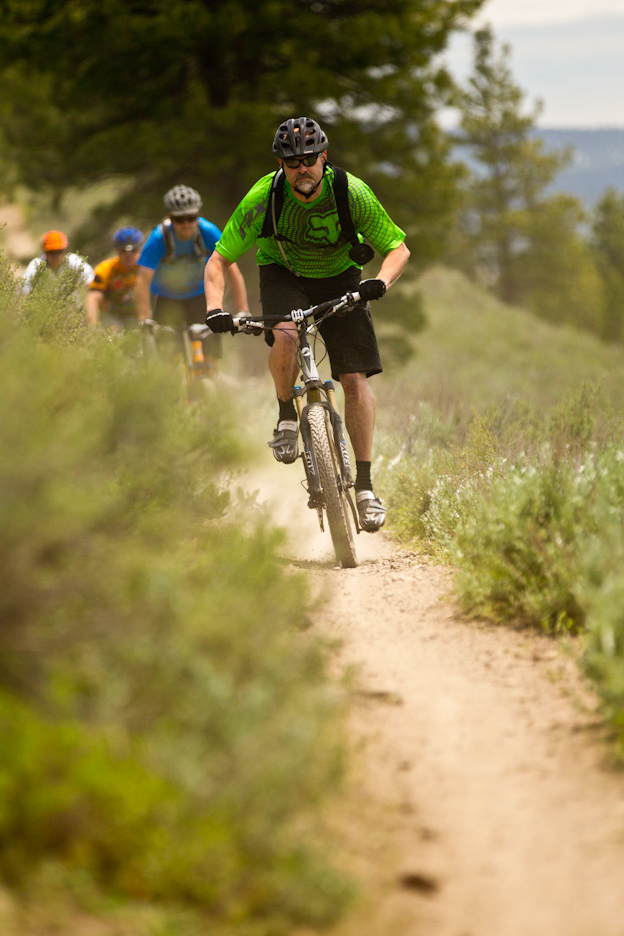
There aren’t many times when I’m leading the pack, so I enjoyed this moment of glory and pushed hard. Thankfully, the cranks were stiff enough to put down the power without any noticeable flex. || Photo: Sterling Lorence
After breaking the outer plate of the cage on a long-cage XTR derailleur last year, I’ve decided the medium cage option is a better choice in the rough terrain around BC. Fewer impacts with roots, rocks and other trail debris are a good thing.
Shifting from the granny to middle ring with the front derailler was particularly good, even under load. Shifts from middle to big ring were an oddity, given the fact that I generally use a double and bashguard set-up, but they were really smooth for the time I ran the big ring. I did run into a few minor rubbing issues in NorCal when I was cross-chaining from big ring to big cog, but that’s not exactly surprising. Chain rub disappeared once the big ring was removed.
Chains are hard to say much about, but I will say that I dislike having to use a pin (as you do with Shimano chains) rather than a master link (like SRAM chains use) in my chains. Cleaning, swapping drivetrains between bikes and just general bike maintenance are so much easier when you can take the chain off quickly and easily. That may just be me, though…
Wheels
Wheels are one of those things that are hard to evaluate, especially if they fall in the middle of the spectrum with things like weight. And that’s where the XT wheels come in – at a claimed 1,795g for a 15mm front and 142mm rear combo, they’re not the lightest or the heaviest wheels out there. They spin up to speed relatively well without having the zip of light-weight wheels. (For comparison, that weight is only 95g heavier than the XTR Trail wheels with the same hubs.)
Durability has been fine thus far, but we’ll have to see how it holds out over the longer term. I broke a spoke on the XTR rear wheel after a couple of rides, and am curious to see how the XT rear wheel will hold up to abuse on a 6” bike piloted by someone who isn’t exactly a featherweight himself. My real issue with this wheelset, however, is what you don’t see – a 20mm front hub option. More on that below…
I’ve mounted up a set of tubeless tires on these wheels and they seated quickly and easily, with a floor pump. The rim bed seems to be wide enough to handle a 2.35″ tire just fine and I haven’t found that there’s any tendency for them to roll on the rim.
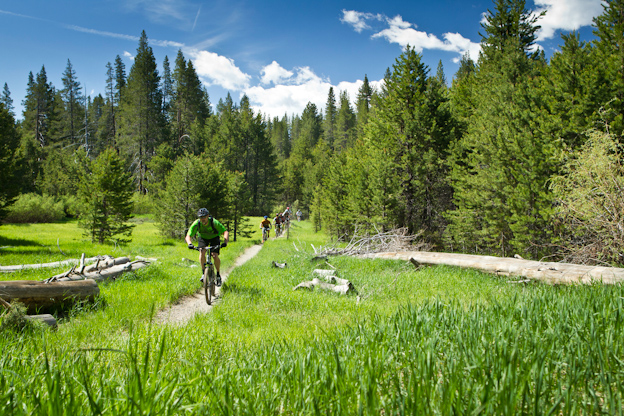
A 15mm front hub is just fine in this kind of terrain, but not great when you’re pushing 220 lbs and you’re in the gnar. || Photo: Sterling Lorence
Pedals
The XT Trail pedals are one of the biggest revelations of the new group, as far as I’m concerned. A less costly and only slightly heavier version of the new XTR Trail pedal introduced last summer, they offer very positive engagement when you clip in, a platform for additional foot support and a larger surface area on the pedal body.
My foot used to pop out of the previous generation of Shimano clipless pedals far too easily – even with the tension cranked all the way down – because there was very little surface area to support your foot when it rolled in one direction or another. The new pedals allow for some natural foot movement and body English without disengaging, so you don’t have to worry about parting company from the pedals without warning.
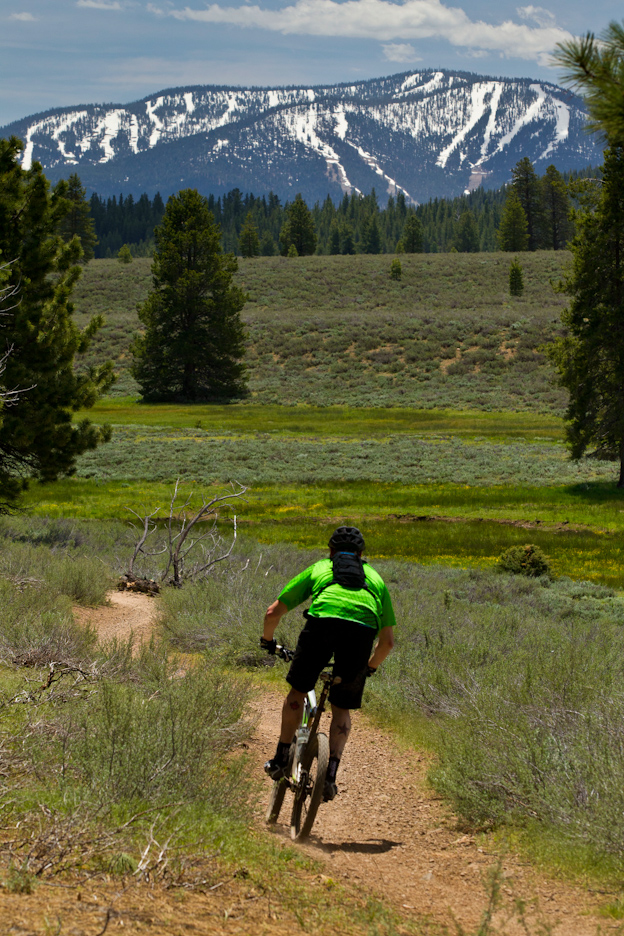
Standing on small pedals for a long time can lead to sore feet. That’s not an issue with the new XT Trail pedals, thankfully. || Photo: Sterling Lorence
The XT Trail pedals are also very similar to the XTR Trail pedals in terms of weight. The XT pedals come in at 403 grams, compared to 398g for the XTR version. So far, I’ve been very happy with the performance in both dry and slightly wetter conditions that we’ve been experiencing on the Shore this summer.
The larger surface area has been a definite plus on longer descents, when you’re spending more time standing. The larger pedal surface area means that your weight is spread out over a greater area of your foot (and shoe), so you’re less likely to get foot pain or cramping during that epic ride.
If I was in charge at Shimano…
Although I liked a number of things about the new XT group – shifting technology, braking power, flex-free cranks and pedals were the big pluses – there were two things that didn’t sit right with me: there is no 20mm XT front hub option, and there is no Shimano bashguard.
I understand the rationale behind a 15mm hub when you’re designing components for racers, lighter riders or trail bikes. It makes sense with Shimano’s XTR group (both the Race and Trail versions). To me, though, the XT component group is about all-mountain riding.
XT is slightly beefier, perhaps just that little less delicate than XTR, and should be able to take a bit more punishment. It’s perfect for riders who are pushing harder and riding more aggressive terrain. For a lot of people – myself included – that will mean running a fork with a 20mm front axle.
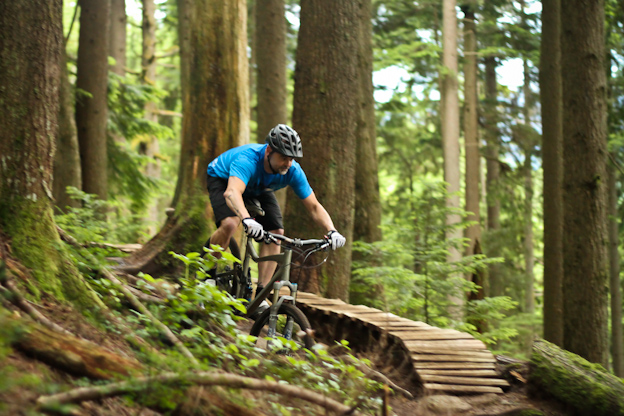
This is the home turf. The XT parts that survived the transition over to my Shore XC rig (also known as an all-mountain bike in most other parts of the world), have been working well. What you don’t see is the Straitline bashguard and a 160mm fork with a 20mm, non-Shimano front hub. || Photo: Vicki Cunningham
Forks with a 20mm front axle generally come with 36mm stanchions, 160mm or more of travel and a larger crown. They’re stiffer on certain types of terrain, for certain riders (especially those in excess of 200 lbs). They don’t have the same flex as a fork with a 15mm axle and 32mm stanchions in slow-speed corners where you’re cranking those nice wide bars to make that tight switchback, or navigate around a root / rock / obstacle, or when you’re rolling down a super steep ramp from 8′ up in the air.
I know for a fact that I’m not the only rider who runs a fork that takes a 20mm front hub on their 6” bike. So when a company decides to cater to only one segment of the mountain buying public by only offering one front hub option, they’re losing business from riders who don’t necessarily follow the latest trends.
If I’m the average consumer looking for a new AM wheelset, I’m not buying the XT front wheel because it doesn’t work with the 20mm fork I already have. I’m also not buying the rear XT wheel because I’m a vain SOB and it doesn’t match the hub and rim combo that I choose to (or am forced to) run in the front.
In my opinion, Shimano should be offering a 20mm XT front hub in ADDITION to the 15mm version. Hell, take a Saint front hub, change the graphics, mount it on an XT rim and I’d be happy with that.
The other thing that is missing from the new group (and Shimano mountain bike groups in general) is a Shimano bashguard. Plenty of riders choose to run a double ring and bashguard on their bikes because of the terrain they tackle on a daily basis, including me.
But because Shimano doesn’t make its own bashguard, people have to put after-market bashguards on Shimano triple cranksets. I’m currently running a Straitline bashguard on my new XT crankset, and an FSA bashguard on my XTR crankset. As far as I’m concerned, this is a missed opportunity for Shimano from an aesthetics perspective, from a branding perspective and from a systems integration perspective. Offer a Shimano bashgard to the people and they’ll use it.
So there you have it – my first, second and third impressions on the new XT group. There were some really good things, some good things and some things that came up a bit short. I’m looking forward to putting in many more miles on XT to see how it will hold up to some of the world’s most punishing riding conditions. Stay tuned for a complete review, which will come after several months of serious beating on the parts.
There you have it – first, second and third impressions of Shimano’s new XT group. What do you think? Going to be shopping for new parts? Going to stick with your old XT thumbshifters instead? Rail against new technology / spread the love on the boards.







Comments
Please log in to leave a comment.